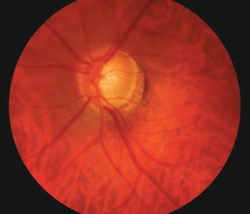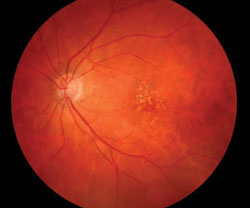Personalized ophthalmic medicine in early stages of development
Two patients come to your busy clinic with the following scenarios: a patient with neovascular age-related macular degeneration wants to know whether he would benefit from intravitreal Avastin (bevacizumab, Genentech) injection for his condition, and you wonder why one of your patients does not respond to latanoprost.
The potential answer and explanation to all these scenarios may arise from better understanding of pharmacogenetics and pharmacogenomics (PGX).
Pharmacogenetics studies irregular responses
The clinical experience of variable drug responses had been known for more than a century, but it was not until the late 1950s that the discipline of pharmacogenetics was proposed by pharmacologists who discovered that different levels and activities of drug metabolizing enzymes accounted for variations in drug responses.
Pharmacogenetics has become an important pharmacological discipline that studies the irregular responses seen in patients with genetic differences. In eye care, the contribution of genetic variation to individual response to therapy has been widely appreciated by clinicians for decades. A well known example is that light irises respond faster and more effectively with dilating drops than dark irises.
 Images: Hua LV  |
|
With the successful completion of the Human Genome Project and rapid advances in genomics research aided by statistical analyses, scientists are able to investigate more complex questions regarding the effects of multiple genes (genomics) and proteins (proteomics) on drug therapy in a related field of pharmacogenomics. This may bring the promise of personalized pharmacotherapy closer to daily clinical practice for common diseases based on the patient’s genotype and disease subtype.
Personalized medicine based on genomics knowledge has the potential for tailoring the right dosage for the right patient to maximize effectiveness and minimize adverse drug reactions. Already a number of PGX tests are routinely done as part of pharmacotherapy for various medical conditions to minimize adverse drug reactions.
Current applications of PGX in medicine
It has been known for a long time that those patients with glucose-6-phosphate dehydrogenase (G6PD) deficiency are prone to hemolysis after intake of certain drugs such as aspirin, sulfamethoxazole and chloroquine. Warfarin, an anticoagulant, is another excellent example in which the PGX test is essential to predict the therapeutic dose to minimize the side effect of excessive bleeding. CYP2C9 and the vitamin K epoxide reductase (VKORC1) enzymes are responsible for its metabolism.
Polymorphisms in CYP2C9 are found primarily in Caucasians, and polymorphisms in VKORC1 are found often in African- and Asian-Americans and can account for up to 40% dose variations in patients. Recently, the International Warfarin Pharmacogenetics Consortium has recommended the use of an algorithm based on PGX testing of CYP2C9 and VKORC1 to optimize precise dosing of warfarin.
The field of pharmacogenomics in eye care is still in its early development; however, significant progress has been made recently in understanding more common and complex eye disorders by genome wide association studies. These studies have found strong associations of certain polymorphisms in the complement factor H (CFH) gene to pathogenesis of neovascular AMD and the lysyl oxidase-like 1 (LOXL1) gene to pathogenesis of pseudoexfoliation syndrome. Further genetic studies on CFH and LOXL1 have shown that single nucleotide polymorphisms (SNPs) in these genes may account for variable responses in patients to ocular therapy.
Scenario 1: Avastin for AMD
Intravitreal injection of antiangiogenic drugs such as Lucentis (ranibizumab, Genentech) and Avastin is widely used for the treatment of neovascular AMD. A recent study has shown that about 53% of CFH-Y402H patients with TT and TC genotype demonstrated improved visual acuity with intravitreal Avastin treatment, whereas only 10% of the patients with CC genotype demonstrated improved visual acuity with this drug. Similarly, individuals with CC genotype were found to require further intravitreal injection of Lucentis compared to individuals with TT or TC genotype.
Scenario 2: No response to latanoprost
There is a group of patients that may not respond favorably to prostaglandins as initial drug of choice for glaucoma management. A recent report from Japan suggested that SNPs in the prostaglandin F2-á receptor gene may underlie this finding and that genotyping of these SNPs may be important in determining the variability in response to latanoprost.
Genetic testing: Where we are now
While the promise of personalized medicine from PGX testing is real and forthcoming, the field is still in its early days. Personalized ophthalmic medicine is not here yet, but recent progress in genomics research and better understanding complex ophthalmic conditions offers new avenues to address PGX questions and may bring the field closer to clinical translation.
Although strong emphasis is being put on genomics discovery research, much less is focused on integration of the novel knowledge into clinical practice or on how the field may affect health care. Nevertheless, this weak link has not deterred the rapid direct-to-consumer marketing of genomics applications that have been conceived by genomics experts as “lost in translation” or “premature translation.”
Direct-to-consumer advertising
Currently, more than 20 companies advertise their genetic sequencing services directly to the consumer. For about $2,000 (a complete scan) or $500 (a cancer or cardio scan), consumers can have their genome scanned by one of the suppliers using the genetic information collected in a self-sample kit. The supplier will calculate and inform them about their genetic risks for 50 diseases and traits including heart attack, lung cancer, breast cancer, neurological conditions, AMD and glaucoma. Furthermore, another supplier can provide a complete scan for less than $500 with 148 reports.
A recent evaluation of 24 companies offering online direct-to-consumer genetic tests concluded that many controversial risk assessment tests were performed and reported to consumers directly without much participation of primary care providers. In addition, the extent, scope, duration and nature of counseling were left to the discretion of the suppliers.
Consequently, physicians may be obligated, if it has not already happened, to fill in as counselors for this newly generated genetics information that patients bring into their offices. So, physicians should beware and prepare to answer possible questions from their patients.
The field of personalized ophthalmic medicine is in its early development with a few infant steps in confirming potential genomics contributions to variable drug responses. Over the decade, we will continue to see progress in understanding complex ocular diseases such as AMD, glaucoma and diabetic retinopathy.
In parallel, continual pharmacogenomics research discoveries will be made and translated into clinical practice. But before any clinical PGX application takes place in eye care, public education and physician training are necessary for its successful and effective application.
For more information:
- Len V. Hua, OD, PhD, FAAO, is an assistant professor at Pacific University College of Optometry. He did a residency in primary eye care at Pennsylvania College of Optometry, holds a PhD in pharmacology from the University of Toronto and conducted postdoctoral research at the National Institute of Environmental Health Sciences and the National Cancer Institute. He can be reached at 2043 College Way, Forest Grove, OR 97116; (503) 352-3059; fax: (503) 352-2929; e-mail: lenvhua@pacificu.edu. Dr. Hua has no direct financial interest in the products mentioned in this article, nor is he a paid consultant for any companies mentioned.
References:
- 23andme: https://www.23andme.com/store. Accessed April 27, 2010.
- deCODEme: https://www.decodeme.com/store. Accessed April 27, 2010.
- Geransar R, Einsiedel E. Evaluating online direct-to-consumer marketing of genetic tests: informed choices or buyers beware? Genet Test. 2008;12:13-23.
- Hunter DJ, Khoury MJ, Drazen JM. Letting the genome out of the bottle – will we get our wish? N Engl J Med. 2008;358(2):105-107.
- Khoury MJ. The future of public health genomics and why it matters for personalized medicine and global health. Current Pharmacogenetics and Personalized Medicine. 2009;7:158-163.
- Klein TE, Altman RB, Eriksson N, et al. Estimation of the warfarin dose with clinical and pharmacogenetic data. N Engl J Med. 2009;360:753-764.
- Lee AY, Rava AK, Kvmes SM, et al. Pharmacogenetics of complement factor H (Y402H) and treatment of exudative age-related macular degeneration with ranibizumab. Br J Ophthalmol. 2009; 93:610–613.
- PharmGKb: http://www.pharmgkb.org/. Accessed April 27, 2010.
- Sakurai M, Higashide T, Takahashi M, et al. Association between genetic polymorphisms of the prostaglandin F2alpha receptor gene and response to latanoprost. Ophthalmology. 2007;114:1039–1045.
- Sheffield LJ, Phillimore HE. Clinical use of pharmacogenomic tests in 2009. Clin Biochem Rev. 2009;30:55-65.
- Shurin SC, Nabel EG. Pharmacogenomics – ready for prime time? N Engl J Med. 2008;358(10):1061-1063.
